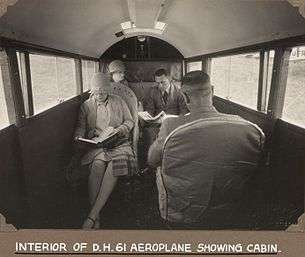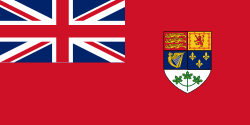de Havilland Giant Moth
| DH.61 Giant Moth | |
|---|---|
 | |
| The arrival of QANTAS DH.61 'Apollo,' bringing the first air mail to Brisbane on April 23, 1929. Notice the pilot's open cockpit behind the wings. | |
| Role | Transport Biplane |
| Manufacturer | de Havilland |
| First flight | 1927 |
| Introduction | 1928 |
| Number built | 10 |
|
| |
The de Havilland DH.61 Giant Moth was a 1920s British large single-engined biplane transport built by de Havilland at Stag Lane Aerodrome, Edgware.
History


Following the success of the de Havilland DH.50 in Australia, the company was asked to design a larger replacement using a Bristol Jupiter engine. The cabin had room for up to eight passengers with the pilot in an open cockpit behind the wings. The aircraft took only ten weeks to design and the prototype first flew in December 1927. Following test flights in England, the aircraft was sent to de Havilland Australia in Melbourne. It first flew after reassembly on 2 March 1928 and was used on scheduled services between Adelaide and Broken Hill by MacRobertson Miller Aviation. The prototype was originally called Canberra which was used as a type name until it was changed to Giant Moth.
Ten aircraft were built (including one in Canada built from components). Two aircraft for Canada were fitted with Short Brothers floats at Rochester before delivery to Western Canada Airlines Ltd.
Three aircraft were used in Australia on air mail services by Australian Aerial Services Ltd and QANTAS. The two QANTAS Giant Moths, Apollo (G-AUJB) and Diana (G-AUJC), were acquired in April[1] and May 1929[2] respectively. They were the first QANTAS aircraft equipped with toilets.[3] The airline took them out of service in 1935 because the Bristol Jupiter XI engines were unreliable.[3] Apollo was sold that year and crashed near Mubo, New Guinea, on May 9, 1938.[1]
Another aircraft, Geraldine (G-AAAN), was bought by the Daily Mail to carry a photographer and his motorcycle around the United Kingdom;[4] the aircraft would land at the nearest airfield to the story. This aircraft was also equipped with a dark room to enable the photographs to be developed on the return journey.[4] Later, it was sold to National Flying services and renamed Leone.[4] Western Australian Airways acquired it in the early 1930s; it served Western Australia from 1931 to 1935.[4][5] When the airline encountered financial difficulties, it was sold to New Guinea Airlines.[6] It crashed on August 20, 1935, while landing at Wau, New Guinea.[6]
One aircraft (G-AAEV) named Youth of Britain was used by Alan Cobham in an aviation promotional tour of the United Kingdom lasting 21 weeks and ending in October 7, 1929.[7] During the tour, Cobham flew 60,000 miles (97,000 km), visited 110 towns and took aloft 40,000 passengers, including 10,000 schoolchildren free of charge.[7] Among those who experienced their first flight in Cobham's Giant Moth was Eric Lock, who grew up to become a Royal Air Force fighter ace during the Battle of Britain.[8]
Operators
 Australia
Australia
- Guinea Airways Ltd
- Holden Air Transport Ltd
- MacRobertson Miller Aviation Company Ltd
- QANTAS
- West Australian Airlines Ltd
 Brazil
Brazil
 Colombia
Colombia
- Avianca
 Canada
Canada
- London Air Transport Ltd
- Ontario Provincial Air Services
- Western Canada Airways Ltd
 United Kingdom
United Kingdom
- Alan Cobham Aviation Ltd
- Associated Newspapers Ltd
- Imperial Airways Ltd
- National Flying Services Ltd
Specifications
Data from Jackson p.99
General characteristics
- Crew: one
- Length: 39 ft 0 in (11.89 m)
- Wingspan: 52 ft 0 in (15.85 m)
- Height: 13 ft 1 in (3.99 m)
- Wing area: 613 ft² (56.95 m²)
- Empty weight: 3,650 lb (1,656 kg)
- Max. takeoff weight: 7,000 lb (3,175 kg)
- Powerplant: 1 × Bristol Jupiter XI radial piston engine, 500 hp (373 kw)
Performance
- Maximum speed: 132 mph (212 km/h)
- Range: 450 mi (724 km)
- Service ceiling: 18,000 ft (5,485 m)
References
| Wikimedia Commons has media related to De Havilland DH.61 Giant Moth. |
- 1 2 "G-AUJB de Havilland D.H.61 Giant Moth". Ed Coates' Civil Aircraft Photograph Collection. Retrieved July 30, 2013.
- ↑ "VH-UJC de Havilland D.H.61 Giant Moth". Ed Coates' Civil Aircraft Photograph Collection. Retrieved July 30, 2013.
- 1 2 "de Havilland DH61 Giant Moth "Apollo" (Replica)". Qantas Founders Museum. Retrieved July 30, 2013.
- 1 2 3 4 Ian Howell. "The De Havilland DH61 Giant Moth in Western Australia". The Airways Museum & Civil Aviation Historical Society. Retrieved July 30, 2013.
- ↑ "Western Australian Airways". Royal Australian Air Force Association (W.A.Division) Inc. Retrieved July 30, 2013.
- 1 2 "VH-UQJ de Havilland D.H.61 Giant Moth". Ed Coates' Civil Aircraft Photograph Collection. Retrieved July 30, 2013.
- 1 2 "Sir Alan Cobham's Tour Ended". Flight Magazine. October 11, 1929.
- ↑ "P/O E S Lock". Battle of Britain London Monument. Retrieved July 30, 2013.
- The Illustrated Encyclopedia of Aircraft (Part Work 1982-1985). Orbis Publishing.
- Jackson, A.J. (1973). British Civil Aircraft since 1919 Volume 2. London: Putnam. ISBN 0-370-10010-7.